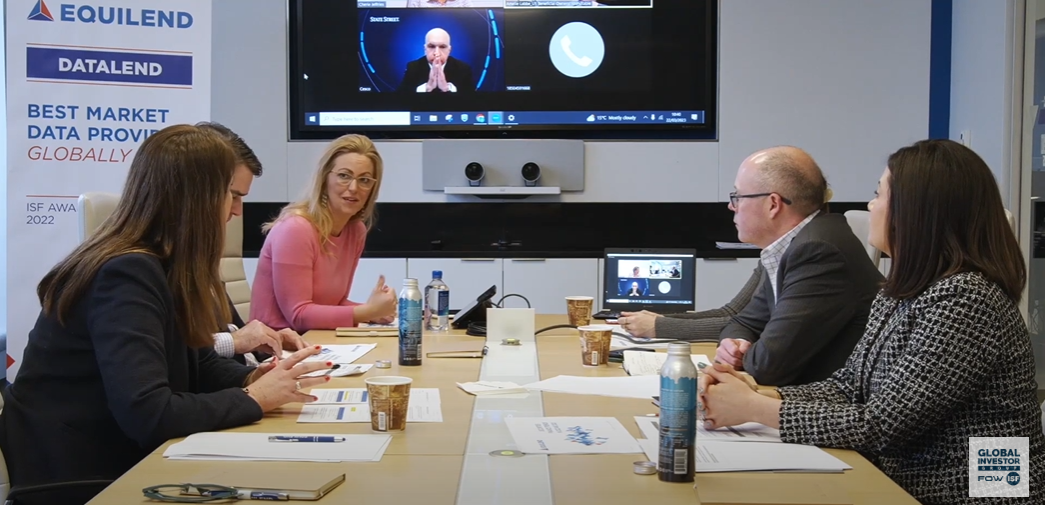US Beneficial Owners Roundtable 2023: Measuring and tracking costs, risks and performance

Measuring and tracking costs,
risks and performance
During March 2023, Global Investor/ISF held the annual US Beneficial Owners’ Roundtable in New York with the help of EquiLend as the lead sponsor. The roundtable was moderated by Global Investor’s Managing Director who was joined by an esteemed group of speakers to discuss recent trends, developments and challenges
in the securities finance space.
A portion of the 2023 US Beneficial Owners Roundtable is available in the video above. See below for a transcript of the highlights.
Amélie Labbé, Managing Director, Global Investor Group: One of the big topics that we kind of bring up every roundtable is, measuring, tracking, cost risk performance. My first question for you is what tools do you think are working in the current environment? What data do you look at? Is it of interest to you to measure this performance effectively, but also to keep an eye on competition.
Brooke Gillman, Global Head of Client Relationship Management, eSeclending: As a lender, you need to know your comparative data set and make sure that it is the right comparative. We are a bit different than the custodial banks or a more traditional agents in that we don’t run a pooled program, so every client truly has a different program, and this makes it even more challenging to identify the appropriate peer comparison set.
Today, more clients are using securities lending for different reasons. Many are no longer lending for the sake of lending only. The point is that every program is uniquely different, and you need to appreciate that and apply it when you’re looking at the comparative data sets. Otherwise, it’s going to be confusing and will lead to the wrong conclusions about performance.
Lenders need to understand why their program may differ from others and know how to assess their own performance. Understanding why you look a particular way within your peer universe is key and knowing what levers can be applied to make a change to performance is important.
The other thing I would say we’re seeing is the level of beneficial owner engagement on data is very different today than it was many years ago. If you roll the clock back 25 years in this industry, there was no data available. That has changed dramatically and now there’s very good data from several different sources. It’s daily information. You can have data overload quite easily, but how do you use data in an efficient way to make different decisions is what is important.
Mike Stamm, Director of Financing & Collateral Management, State of Wisconsin Investment Board: Brooke, I think you highlight a struggle we certainly have, which is, finding good apples to apples comparisons. We certainly have peer beneficial owners who likely have similar books to us, but they may not view collateral schedules the same, or may not use cash collateral the same way, so their economics become very different.
One thing we try to do through data is to understand the important positions in our book, where do we have an opportunity to really earn some revenue? We focus on that stuff on a ticker level, and beyond that, it is as you have mentioned, we try to find novel ways to utilise that more commoditised part of our book in a way that can help us differentiate our pool of GC from other similar pools.
John Templeton, Global Head of Sales and Relationship Management for Securities Finance, BNY Mellon: I think it’s also where the regulations start to align with the data as well. If you think about T+1 settlement coming in and the advent of potentially increasing fails, being able to see what drove fails is going to end up being very helpful.
A key for our clients will be how quickly they’re able to provide their sales/recalls to their agent to be able to make sure that their assets are being returned to their custodial account as quickly as possible.
We also see a lot of demand from clients. It’s not just whether the data is available, it’s how data is available and how to make it easier for them to be able consume it into their systems.
That flexibility to be able to set up reports in multiple different ways, whether it’s a report, or it’s a data extract, or an API that’s going system to system to a client. There are a number of clients who are looking for that type of data to be able to analyse it faster than they did before.
Found this useful?
Take a complimentary trial of the FOW Marketing Intelligence Platform – the comprehensive source of news and analysis across the buy- and sell- side.
Gain access to:
- A single source of in-depth news, insight and analysis across Asset Management, Securities Finance, Custody, Fund Services and Derivatives
- Our interactive database, optimized to enable you to summarise data and build graphs outlining market activity
- Exclusive whitepapers, supplements and industry analysis curated and published by Futures & Options World
- Breaking news, daily and weekly alerts on the markets most relevant to you



